
Detour is a 1945 American independent film noir directed by Edgar G. Ulmer starring Tom Neal and Ann Savage. The screenplay was adapted by Martin Goldsmith and Martin Mooney (uncredited) from Goldsmith's 1939 novel of the same title, and released by the Producers Releasing Corporation, one of the so-called Poverty Row film studios in mid-20th-century Hollywood. The film, which today is in the public domain and freely available for viewing at various online sources, was restored by the Academy Film Archive in 2018. In April that year, the 4K restoration premiered in Los Angeles at the TCM Festival. A Blu-Ray and DVD was released in March 2019 from the Criterion Collection. In 1992, Detour was selected for the United States National Film Registry by the Library of Congress as being "culturally, historically, or aesthetically significant".

Edgar Georg Ulmer was a Jewish-Moravian, Austrian-American film director who mainly worked on Hollywood B movies and other low-budget productions, eventually earning the epithet 'The King of PRC', due to his extremely prolific output for the Poverty Row studio. His stylish and eccentric works came to be appreciated by auteur theory-espousing film critics in the years following his retirement. Ulmer's most famous productions include the horror film The Black Cat (1934) and the film noir Detour (1945).

The Black Cat is a 1934 American pre-Code horror film directed by Edgar G. Ulmer and starring Boris Karloff and Béla Lugosi. It was Universal Pictures' biggest box office hit of the year, and was the first of eight films to feature both Karloff and Lugosi. In 1941, Lugosi appeared in a comedy horror mystery film with the same title, which was also named after and ostensibly "suggested by" Edgar Allan Poe's short story.
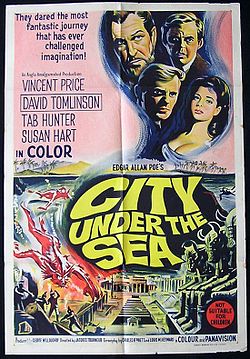
City Under the Sea is a 1965 British-American adventure horror science fiction film. It was directed by Jacques Tourneur and starred Vincent Price, Tab Hunter, Susan Hart and David Tomlinson.
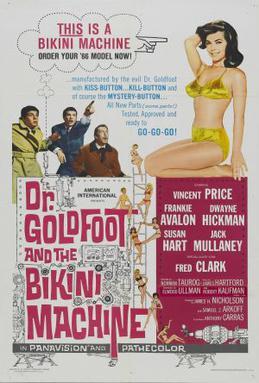
Dr. Goldfoot and the Bikini Machine is a 1965 Pathécolor comedy film directed by Norman Taurog and distributed by American International Pictures. Starring Vincent Price, Frankie Avalon, Dwayne Hickman, Susan Hart and Jack Mullaney, and featuring Fred Clark, the film is a parody of the then-popular spy trend, made using actors from AIP's beach party and Edgar Allan Poe films. The film was retitled Dr G. and the Bikini Machine in England due to a threatened lawsuit from Eon, holder of the rights to the James Bond series.
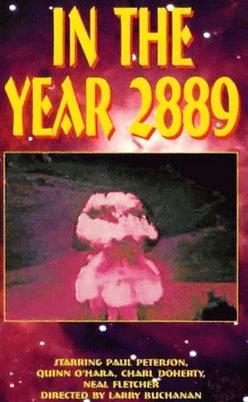
In the Year 2889 is a 1969 American made-for-television horror science fiction film from American International Pictures about the aftermath of a future nuclear war. The film stars Paul Petersen, Quinn O'Hara, Charla Doherty, Neil Fletcher and Hugh Feagin. AIP commissioned low-budget cult film auteur Larry Buchanan to produce and direct this film as a color remake of Roger Corman's 1956 film Day the World Ended.

Captive Women is a 1952 American black-and-white post-apocalyptic science-fiction film. It stars Robert Clarke and Margaret Field. The film has a running time of 64 minutes. It deals with the effects of a nuclear war and how life would be afterwards.
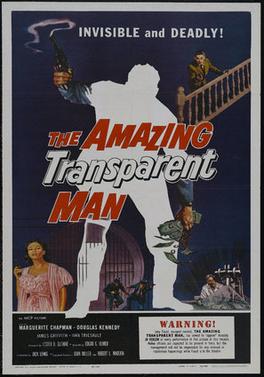
The Amazing Transparent Man is a 1960 American science fiction thriller B-movie starring Marguerite Chapman in her final feature film. The plot follows an insane ex–U.S. Army major who uses an escaped criminal to steal materials to improve the invisibility machine his scientist prisoner made. It was one of two sci-fi films shot back-to-back in Dallas, Texas by director Edgar G. Ulmer. The combined filming schedule for both films was only two weeks. The film was later featured in an episode of Mystery Science Theater 3000.

The Astounding She-Monster is a 1957 science fiction horror film starring Robert Clarke and directed, co-written and produced by Ronnie Ashcroft for Hollywood International Productions. The film focuses on a geologist, a gang which has kidnapped a rich heiress, and their encounter with a beautiful but deadly female alien who has crashed to Earth. In the UK, it was released as The Mysterious Invader. The film was released in American theaters on 1957 by American International Pictures on a double feature with Roger Corman's The Saga of the Viking Women and Their Voyage to the Waters of the Great Sea Serpent.
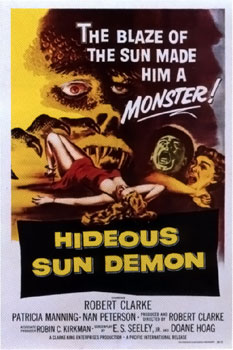
The Hideous Sun Demon is a 1958 American science fiction horror film produced, directed, and cowritten by Robert Clarke, who also starred in the title role. It also stars Patricia Manning, Nan Peterson, Patrick Whyte, and Fred La Porta. The film focuses on a scientist who is exposed to a radioactive isotope and soon finds out that it comes with horrifying consequences.

Robert Irby Clarke was an American actor best known for his cult classic science fiction films of the 1950s. In succeeding decades he appeared in more conventional television, and in The King Family Show, a variety show based on the family of which his wife Alyce King Clarke was a member.

Flesh and the Spur is a 1956 American western film directed by Edward L. Cahn. The film stars John Agar as Lucius Random, Marla English as Wild Willow and Mike Connors as Stacy Tanner. The film was released by American International Pictures as a double feature with Naked Paradise. The plot is about a young cowboy who searches for the killer of his twin brother.
Arthur C. Pierce was an American screenwriter and director specialising in low budget science fiction films.

Frankenstein Island is a 1981 science fiction horror film produced, written, composed, edited and directed by Jerry Warren and starring John Carradine and Cameron Mitchell. The plot concerns a group of balloonists stranded on an island where they are captured by Dr. Frankenstein's female descendant, Sheila Frankenstein, who has been kidnapping shipwrecked sailors for years and turning them into zombies.

Darlene Tompkins was an American actress.
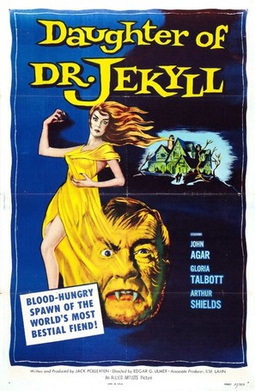
Daughter of Dr. Jekyll is a low-budget black-and-white 1957 American horror film produced by Jack Pollexfen, directed by Edgar G. Ulmer and released by Allied Artists. The film is a variation on the 1886 gothic novella Strange Case of Dr. Jekyll and Mr. Hyde by Robert Louis Stevenson. It stars Gloria Talbott, John Agar and Arthur Shields. In the film, Janet Smith learns that she is not only the daughter of the infamous Dr. Henry Jekyll, but is convinced by her guardian, Dr. Lomas, that she has inherited her father's transformative condition. Janet begins to believe that she turns into a monster after two local women are found horribly killed and nearly takes her own life because of it. However, all is not what it seems.
Leo Erdody was an American film composer of Hungarian descent. He studied music in Germany, and later went to Hollywood, scoring his first film in 1921. He later joined Producers Releasing Corporation and scored several films for them. For his work on Minstrel Man, he was a nominee for an Academy Award for Best Original Score.

Club Havana is a 1945 American film drama directed by Edgar G. Ulmer. It was produced and released by independent film company Producers Releasing Corporation. It has been compared to the 1933 film Grand Hotel.

Paul Blaisdell was an American painter, sculptor and visual effects creator, best remembered for his work in science fiction and horror B movies of the 1950s.

Thunder Over Texas is a 1934 American populist contemporary Western film directed by Edgar G. Ulmer under the alias Joen Warner and produced by two nephews of Universal Pictures head Carl Laemmle, Arthur and Max Alexander's Poverty Row Beacon Productions. The film's story was written by Shirley Ulmer under the name of Sherle Castle. Shirley was then married to Max Alexander but would soon leave Max to marry Edgar with the result that Lammele blacklisted Ulmer from Hollywood. The film was shot in Kernville, California.


















